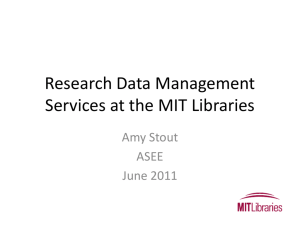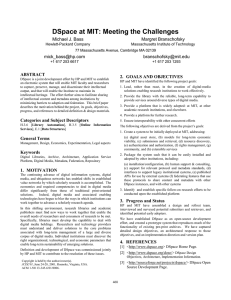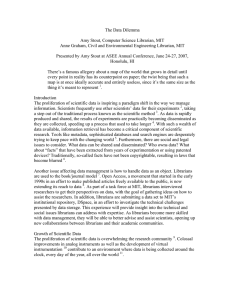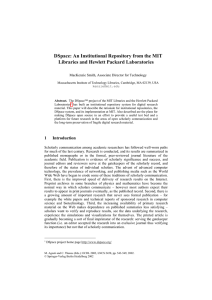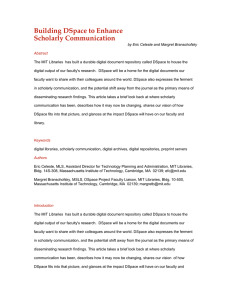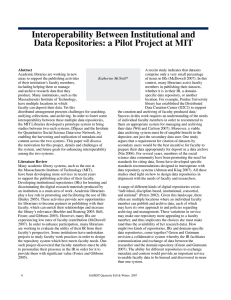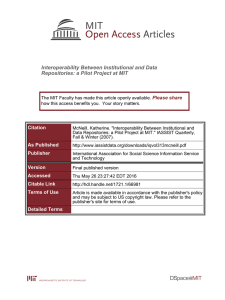DSpace: Durable Digital Documents Margret Branschofsky Daniel Chudnov
advertisement
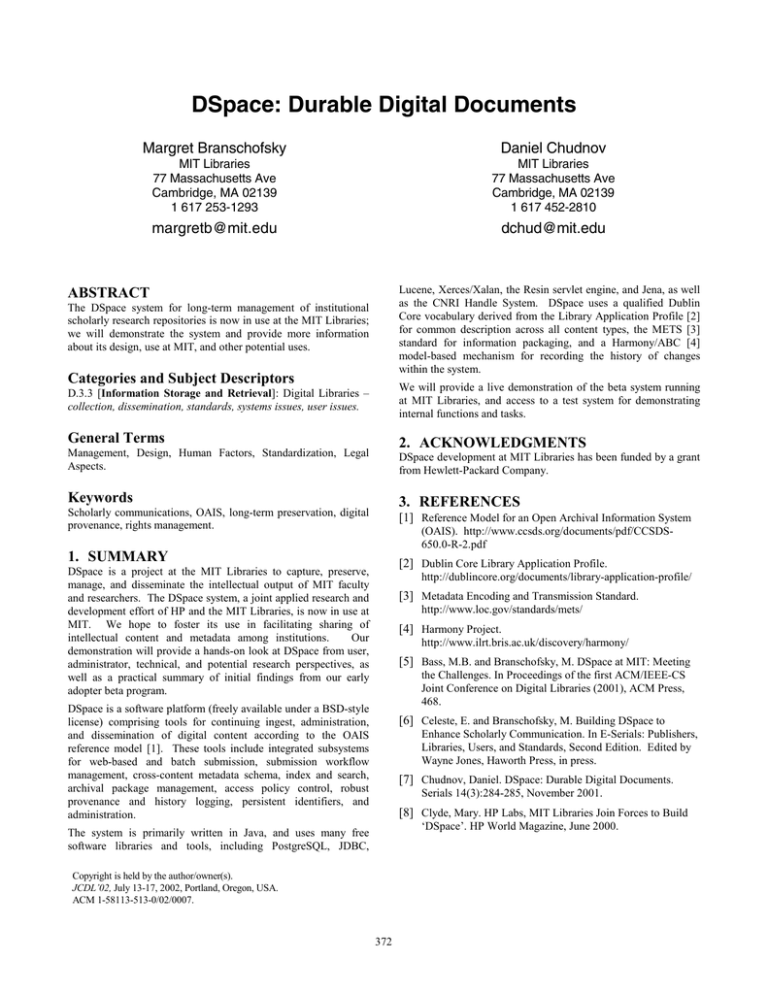
DSpace: Durable Digital Documents Margret Branschofsky Daniel Chudnov MIT Libraries 77 Massachusetts Ave Cambridge, MA 02139 1 617 253-1293 MIT Libraries 77 Massachusetts Ave Cambridge, MA 02139 1 617 452-2810 margretb@mit.edu dchud@mit.edu Lucene, Xerces/Xalan, the Resin servlet engine, and Jena, as well as the CNRI Handle System. DSpace uses a qualified Dublin Core vocabulary derived from the Library Application Profile [2] for common description across all content types, the METS [3] standard for information packaging, and a Harmony/ABC [4] model-based mechanism for recording the history of changes within the system. ABSTRACT The DSpace system for long-term management of institutional scholarly research repositories is now in use at the MIT Libraries; we will demonstrate the system and provide more information about its design, use at MIT, and other potential uses. Categories and Subject Descriptors D.3.3 [Information Storage and Retrieval]: Digital Libraries – collection, dissemination, standards, systems issues, user issues. We will provide a live demonstration of the beta system running at MIT Libraries, and access to a test system for demonstrating internal functions and tasks. General Terms 2. ACKNOWLEDGMENTS Management, Design, Human Factors, Standardization, Legal Aspects. DSpace development at MIT Libraries has been funded by a grant from Hewlett-Packard Company. Keywords 3. REFERENCES Scholarly communications, OAIS, long-term preservation, digital provenance, rights management. [1] Reference Model for an Open Archival Information System (OAIS). http://www.ccsds.org/documents/pdf/CCSDS650.0-R-2.pdf 1. SUMMARY [2] Dublin Core Library Application Profile. DSpace is a project at the MIT Libraries to capture, preserve, manage, and disseminate the intellectual output of MIT faculty and researchers. The DSpace system, a joint applied research and development effort of HP and the MIT Libraries, is now in use at MIT. We hope to foster its use in facilitating sharing of intellectual content and metadata among institutions. Our demonstration will provide a hands-on look at DSpace from user, administrator, technical, and potential research perspectives, as well as a practical summary of initial findings from our early adopter beta program. http://dublincore.org/documents/library-application-profile/ [3] Metadata Encoding and Transmission Standard. http://www.loc.gov/standards/mets/ [4] Harmony Project. http://www.ilrt.bris.ac.uk/discovery/harmony/ [5] Bass, M.B. and Branschofsky, M. DSpace at MIT: Meeting the Challenges. In Proceedings of the first ACM/IEEE-CS Joint Conference on Digital Libraries (2001), ACM Press, 468. DSpace is a software platform (freely available under a BSD-style license) comprising tools for continuing ingest, administration, and dissemination of digital content according to the OAIS reference model [1]. These tools include integrated subsystems for web-based and batch submission, submission workflow management, cross-content metadata schema, index and search, archival package management, access policy control, robust provenance and history logging, persistent identifiers, and administration. [6] Celeste, E. and Branschofsky, M. Building DSpace to Enhance Scholarly Communication. In E-Serials: Publishers, Libraries, Users, and Standards, Second Edition. Edited by Wayne Jones, Haworth Press, in press. [7] Chudnov, Daniel. DSpace: Durable Digital Documents. Serials 14(3):284-285, November 2001. [8] Clyde, Mary. HP Labs, MIT Libraries Join Forces to Build ‘DSpace’. HP World Magazine, June 2000. The system is primarily written in Java, and uses many free software libraries and tools, including PostgreSQL, JDBC, Copyright is held by the author/owner(s). JCDL’02, July 13-17, 2002, Portland, Oregon, USA. ACM 1-58113-513-0/02/0007. 372
